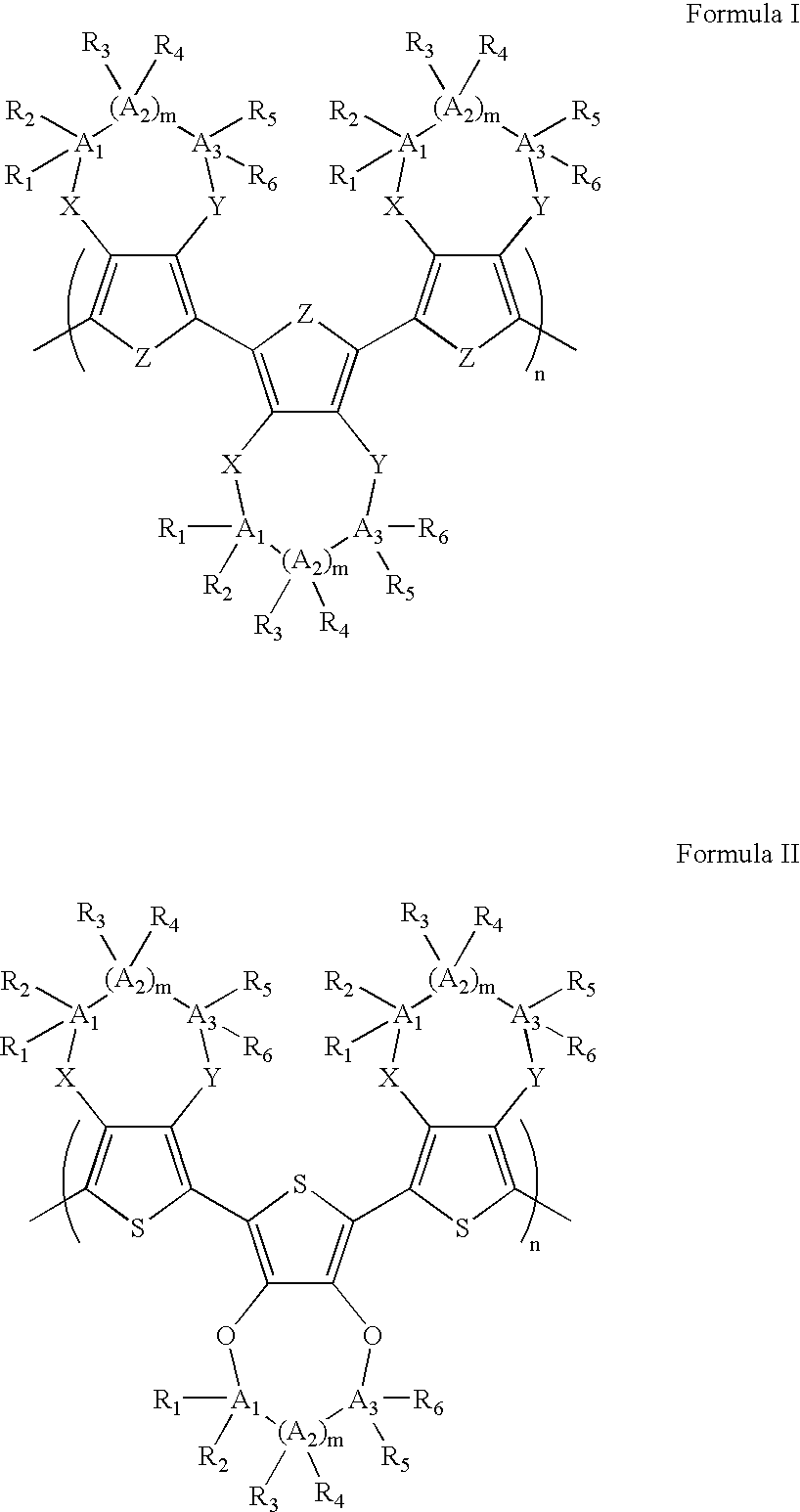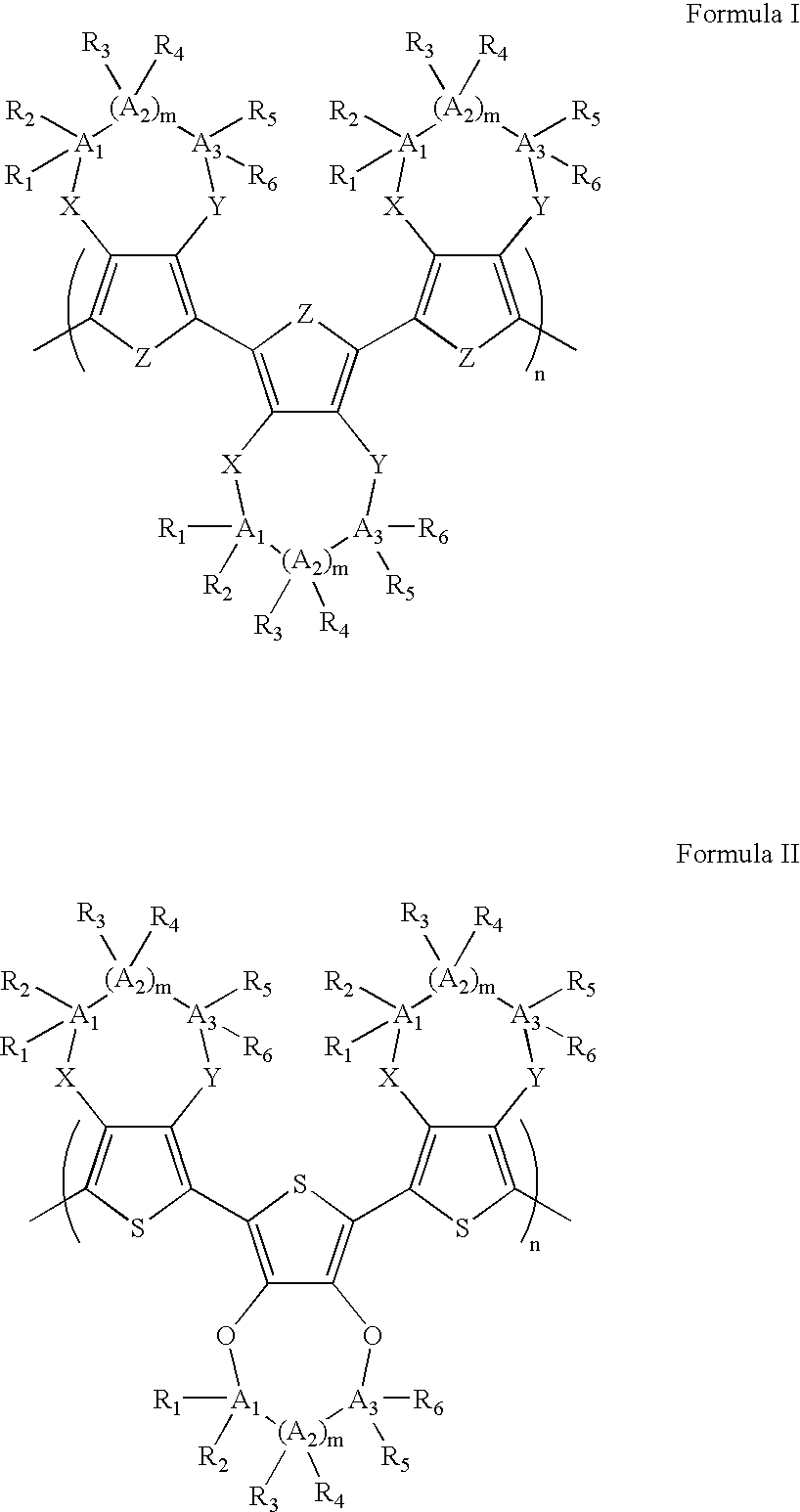Electrochromic polymers and polymer electrochromic devices
a technology of electrochromic devices and polymers, applied in the direction of photosensitive materials, instruments, chemistry apparatuses and processes, etc., can solve the problem of extremely fast switching times of ecds
- Summary
- Abstract
- Description
- Claims
- Application Information
AI Technical Summary
Benefits of technology
Problems solved by technology
Method used
Image
Examples
example 1
Synthesis of Exemplary N-alkyl Substituted Pyrroles
[0115] A series of several of N-alkyl substituted pyrroles can be synthesized in accordance with the subject invention. The N-alkyl substituted poly(3,4-propylenedioxypyrrole)s (PProDOPs) were originally designed as potentially processable electrochromic polymers, featuring the assets of poly(3,4-alkylenedioxypyrrole)s (PXDOPs) (low oxidation potential, outstanding stability to overoxidation and potential switching, and multi-color electrochromism). N-substitution modifies the electron rich character of the heterocycle thus leading to a new set of colors including purple, green, brown and blue. Spectroelectrochemistry showed that the absorbance of the .pi.-.pi.* transition in the neutral state is blue shifted compared to the non N-derivatized PProDOP. In the case of poly(N-glycol ProDOP) (N-Gly PProDOP), this transition displays a maximum at 306 nm (onset at 365 nm) thus giving an almost colorless highly transparent neutral polymer ...
example 2
Optimization of Reflective ECDs
[0136] In this example we address the optimization of ECDs that operate in the reflective mode and are able to modulate the reflectivity in the visible, NIR and mid-IR regions of the spectrum As a device platform which conveniently allows EC property characterization in a reflective mode, we have used an outward facing active electrode device sandwich structure originally described in the patent literature [R. B. Bennett, W. E. Kokonasky, M. J. Hannan, L. G. Boxall, U.S. Pat. No. 5,446,577, 1995; b) P. Chandrasekhar, U.S. Pat. No. 5,995,273, 1999], as shown schematically in FIG. 14. This ECD structure has several benefits. First, the properties of the EC material of interest can be probed through a window chosen to be highly transmissive over the wavelength range of interest. Second, all of the materials can be flexible, allowing significant mechanical deformation without hampering device operation. Finally, by using an especially-designed high viscosi...
example 3
Electrochemical Characterization of High Band Gap Polymers
[0144] This example demonstrates the electrochemical characterization of a high band gap N-butanol derivatized PProDOP (hereafter PProDOP-BuOH). We also report the characterization of solution polymerized C-alkyl substituted PProDOPs which are cast on electrode surfaces from common organic solvents such as chloroform and dichloromethane.
[0145] The chemical structures of the monomers used in this work are depicted in FIG. 15. Chemical polymerization of C-alkyl substituted ProDOPs were carried out in chloroform or methanol with ferric chloride. Free standing films were prepared via filtration through a glass frit under vacuum. Electrochemical polymerization was carried out with an EG&G 273A potentiostat / galvanostat from 0.01M monomer solutions in acetonitrile. 0.1M Et.sub.4NOTs was used as electrolyte. A platinum button electrode was used as a working electrode in a three-electrode cell setup with a platinum flag as the counter...
PUM
| Property | Measurement | Unit |
|---|---|---|
| Electric potential / voltage | aaaaa | aaaaa |
| Electric potential / voltage | aaaaa | aaaaa |
| Electric potential / voltage | aaaaa | aaaaa |
Abstract
Description
Claims
Application Information
 Login to View More
Login to View More - R&D
- Intellectual Property
- Life Sciences
- Materials
- Tech Scout
- Unparalleled Data Quality
- Higher Quality Content
- 60% Fewer Hallucinations
Browse by: Latest US Patents, China's latest patents, Technical Efficacy Thesaurus, Application Domain, Technology Topic, Popular Technical Reports.
© 2025 PatSnap. All rights reserved.Legal|Privacy policy|Modern Slavery Act Transparency Statement|Sitemap|About US| Contact US: help@patsnap.com



